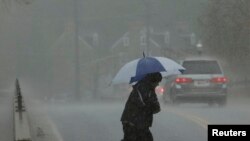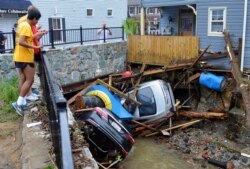Julia Sanger, whose tiny ice cream shop flooded twice in two years in Maryland's historic Ellicott City, joked darkly that the disasters left many local business owners in need of therapy.
Shops on the former mill town's picturesque Main Street are barely back on their feet more than a year after the second flood. Some are boarded up, and others open just a few hours a day. Several heavily damaged buildings are due to be torn down.
"Some of my friends down here, I know they sought professional therapy. I know there's probably some who should have and didn't," said Sanger, whose shop got 6 feet (1.8 m) of muddy floodwater in 2016 and 8 feet in 2018.
"I drink a lot," she added. "I'm not going to lie. I'm definitely drinking more than I did before."
She has also moved her shop to higher ground.
Worsening extreme weather linked to climate change is creating hardships for many, from immediate deaths and injuries to increases in asthma and heat stroke. But the psychological trauma that often accompanies such losses is barely on the map.
Depression, anxiety, suicide and post-traumatic stress disorder tend to increase after floods, storms, wildfires and heat waves, according to the American Psychological Association (APA), which represents psychologists in the United States.
"The problem with that link is it's not like so obvious. It's not like I stick a needle in you, you feel pain right away," said Anthony Ng, former head of the APA's caucus on climate change and mental health.
"Some of this is so insidious and gradual that people won't realize it until it's too late. That's why it's hard for a lot of people to appreciate it."
Panic
The debate over how to safeguard residents of picturesque Ellicott City, a tourist draw an hour's drive north of Washington, D.C., illustrates the challenges many towns are facing as the world becomes warmer and wetter.
The town was devastated in 2016 by a so-called 1,000-year flood — meaning a magnitude with a one-in-1,000 chance of occurring in any year. The Patapsco River, which runs through the town, rose more than 13 feet in less than two hours.
Less than two years later, a 1,000-year storm struck again, overwhelming the tributaries that converge under the old mill town's buildings and feed into the Patapsco.
Warmer temperatures are increasing heavy downpours, and rainfall has been growing in intensity in the Northeast, according to the government's 2018 National Climate Assessment, risking power outages and the viability of roads and bridges.
As Ellicott City has become more built up, floodwater flows across paved roads and rooftops, instead of percolating down through the soil as it used to — a phenomenon known as urban runoff, which is worsening globally as cities grow.
In the wake of the 2018 floods, the county launched the Ellicott City Safe and Sound plan, which involves demolishing some old buildings, making tunnels to carry water under roads and clearing waterways more regularly.
Officials are also testing a flood warning system, with emergency sirens telling people to move to higher ground. It has caused some alarm among residents, said Amy Miller, a social worker at the Grassroots Crisis Intervention Center.
"You almost have a panic response," said Miller, whose non-profit organization, based in Columbia, some 8 miles (13 km) south, has provided food, shelter and support to flood survivors.
"We're basically exposing ourselves to the perceived threat of a traumatic event."
Suicides
Grassroots provides 24-hour counseling to people in Ellicott City and the surrounding rolling hills of Howard County who might be feeling suicidal.
Miller has trained farmers to watch out for each other and spot signs of danger, particularly suicide risks.
Farmers are a high risk group. They tend to live solitary lives, have access to lethal means and face financial stress when hit by poor weather and low prices — factors they cannot control, according to anti-suicide campaigners.
"When your livelihood is impacted, that causes hopelessness," Miller said. "The hard part for farmers is they work almost 24-7, and it's really hard for them to seek treatment."
Stanford University predicted last year that a hotter planet could lead to a surge in suicides by 2050. Its data analysis found suicides had risen 0.7% in the United States and 2.1% in Mexico with a 1°C increase in monthly average temperatures.
The researchers also found — by analyzing the language used in more than a half billion Twitter posts — depressive language increased during hot weather, suggesting worse mental health.
Keith Ohlinger, one of the Howard County farmers trained to keep an eye out, said he was driven to the work by the suicide of a young friend who grew up on a nearby farm, planned a career in agriculture and took her own life last year at age 21.
He struggled this spring with heavy rains washing away seeds and soil and leaving hay too wet to be dried and stored for winter feeding.
"Things are changing," he said. "The Earth is changing, patterns are changing. Things are melting."
Ohlinger uses his position on the Maryland Agricultural Commission, which advises the government on farming, and at monthly farmers club meetings to bring up mental health, often taboo in the conservative agricultural community.
He said climate change was just one more stress for farmers already worried about commodity prices, credit, bank loans, the price of equipment and old family-run farms being squeezed out by more and more giant residential homes known as McMansions.
"I can't fix pricing. I can't fix what the Chinese president or Donald Trump does, but I can surely try and keep someone from killing themselves," Ohlinger said.
Not everyone in the region is willing to make the link between mental health problems and climate change.
Global warming as a manmade phenomenon is a politically divisive topic in the United States, where President Donald Trump announced plans to withdraw from the Paris agreement, a global pact to fight climate change.
"You talk about global warming, but we deal with this stuff all the time," said another Howard County farmer, Howie Feago.
"Most farmers believe it's more of an ebb and flow. We know that the weather is going to be up and down. If you're going to worry about global warming, you probably ought to get some other kind of job because it will drive you nuts."








